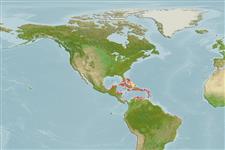Common names from other countries
Environment: milieu / climate zone / depth range / distribution range
Sinh thái học
; Mức độ sâu 0 - 1 m (Ref. 83435). Tropical
Western Central Atlantic.
Length at first maturity / Bộ gần gũi / Khối lượng (Trọng lượng) / Age
Maturity: Lm ? range ? - ? cm Max length : 10.0 cm TL con đực/không giới tính; (Ref. 289)
Maximum depth from Ref. 110502. Epibiotic (Ref. 110502). Intertidal; very common on open shore (Ref. 289); common in the zone between tides in the rocky coast, mainly on rocks of arenaceous; adheres with great force to rocks (Ref. 292); intertidal, spray zones of rocky shores (Ref. 2022, page 122).
Life cycle and mating behavior
Chín muồi sinh dục | Sự tái sinh sản | Đẻ trứng | Các trứng | Sự sinh sản | Ấu trùng
Members of the class Polyplacophora are mostly gonochoric. Life cycle: Eggs hatch into lecitotrophic planktonic trocophore larvae (no veliger stage) which later metamorphose and settle on the bottom as young adults.
Burghardt, G. and L. Burghardt. 2006. (Ref. 281)
IUCN Red List Status (Ref. 130435)
CITES status (Ref. 108899)
Not Evaluated
Not Evaluated
Human uses
| FishSource |
Các công cụ
Thêm thông tin
Age/SizeSự sinh trưởngLength-weightLength-lengthHình thái họcẤu trùngSự phong phú
Các nguồn internet
Estimates based on models
Preferred temperature
(Ref.
115969): 26.3 - 28.4, mean 27.3 (based on 199 cells).
Vulnerability
Low vulnerability (10 of 100).
Price category
Unknown.
